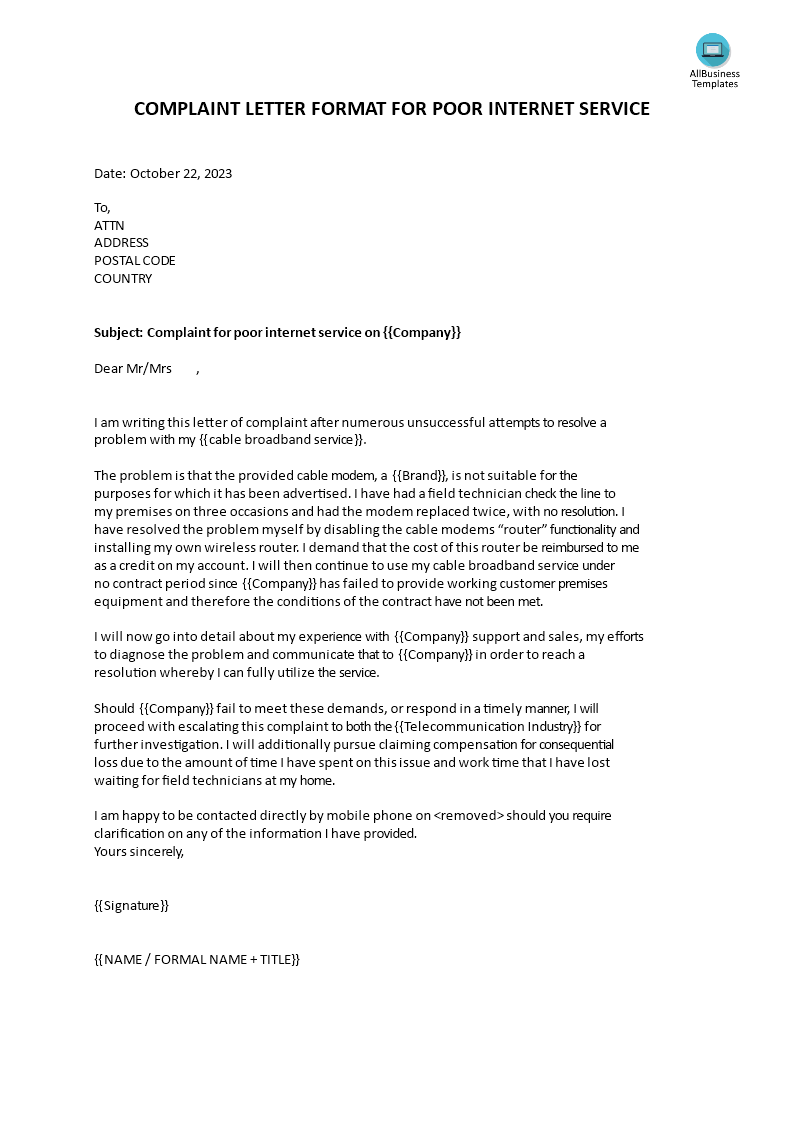Complaint Letter Format For Poor Internet Service
Save, fill-In The Blanks, Print, Done!

Download Complaint Letter Format For Poor Internet Service
Microsoft Word (.docx)Or select the format you want and we convert it for you for free:
- This Document Has Been Certified by a Professional
- 100% customizable
- This is a digital download (22.69 kB)
- Language: English
- We recommend downloading this file onto your computer.
Do you have an urgent concern or complaint and you want to write a Complaint Letter Format For Poor Internet Service? What is the proper way to write a complaint letter about the Internet? Use this template as a guide to write your own letter. Make sure to include your name and contact information, a detailed description of the problem, and any supporting evidence. Send the letter to your ISP and keep a record of it. Download this Complaint Letter now!
A complaint letter is a formal written document in which an individual or organization expresses their dissatisfaction or concerns about a particular issue, product, service, or situation. The primary purpose of a complaint letter is to communicate grievances, seek resolution or redress, and convey dissatisfaction in a clear and professional manner. Complaint letters are typically addressed to the responsible party, whether it's a company, government agency, service provider, or any other relevant entity. They can cover a wide range of issues, such as poor customer service, product defects, billing errors, contract violations, or any other problems that require attention and resolution.
Key elements of a complaint letter include:
- Sender's Information: This includes your name, address, email address, and contact number. It helps the recipient identify and respond to your complaint.
- Date: The date when you are writing the letter.
- Recipient's Information: The name, title, address, and contact information of the person or department responsible for addressing the issue.
- Subject: A concise and descriptive subject line that highlights the main issue you are complaining about.
- Salutation: A formal greeting, such as "Dear [Recipient's Name]" or "To Whom It May Concern" if you don't know the recipient's name.
- Introduction: Start the letter by explaining the reason for writing and providing some context for your complaint.
- Description of the Issue: Clearly and concisely detail the problem or issue you are complaining about. Include specific incidents, dates, and any relevant information.
- Impact: Explain how the issue has affected you or others. Provide examples if necessary.
- Expectations: State what you expect from the recipient in terms of resolution, compensation, or action.
- Supporting Documents: If applicable, mention any attached documents, receipts, or evidence that support your complaint.
- Request for Action: Politely but firmly request prompt action to resolve the issue.
- Closing: Use a courteous closing phrase such as "Sincerely" or "Yours faithfully."
- Signature: Sign the letter by hand if sending a physical copy, or type your name if sending it electronically.
A well-structured complaint letter is an effective way to communicate your concerns and seek a resolution to the problem. Be sure to keep a copy of the letter for your records and follow up as needed if you don't receive a response in a reasonable time frame.
Just download this example Complaint Letter Format For Poor Internet Service template that has been put together for you!
DISCLAIMER
Nothing on this site shall be considered legal advice and no attorney-client relationship is established.
Leave a Reply. If you have any questions or remarks, feel free to post them below.
Related templates
Latest templates
Latest topics
- Christmas Templates
It's Christmas... Be prepared with nice Christmas letters, invitations, social posts etc and check out these Christmas templates now! - GDPR Compliance Templates
What You Need To Be DPR compliant? Are you looking for useful GDPR document templates to make you compliant? All these compliance documents will be available to download instantly... - Google Sheets Templates
How to work with Google Sheets templates? Where to download useful Google Sheets templates? Check out our samples here. - Drop Shipping Agreement
How to start drop shipping? Do you need a Drop shipping Agreement? Check out our Dropshipping Agreement templates now! - Excel Templates
Where to find usefl Excel templates? How do I create a template in Excel? Check these editable and printable Excel Templates and download them directly!
cheese

